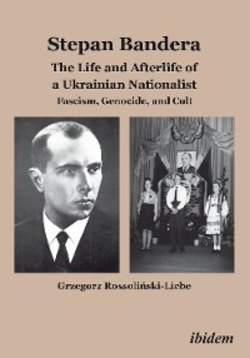Читать книгу Stepan Bandera: The Life and Afterlife of a Ukrainian Fascist - Grzegorz Rossoliński-Liebe - Страница 20
Chapter 1:
Heterogeneity, Modernity, and the Turn to the Right “Longue Durée” Perspective and
the Heterogeneity of Ukrainian History
ОглавлениеStepan Bandera was born on 1 January 1909 in the village of Staryi Uhryniv, located in the eastern part of Galicia, the easternmost province of the Habsburg Empire. Galicia, officially known as the Kingdom of Galicia and Lodomeria (Regnum Galiciae et Lodomeriae), was created in 1772 by the bureaucrats of the House of Habsburg at the first partition of the Polish-Lithuanian Commonwealth (Res Publica Utriusque Nationis). The province was an economically backward region with a heterogeneous population: according to statistics from 1910, 47 percent of the population were Polish, 42 percent Ukrainian, and 11 percent Jewish. The eastern part of Galicia, which the Ukrainian national movement claimed as a part of the Ukrainian nation state, and where the political cult of Stepan Bandera was born, was no less heterogeneous: 62 percent of the population were Ukrainian, 25 percent Polish, and 12 percent Jewish (Maps 1 and 2).[123]
At the time of Bandera’s birth, close to 20 percent of “Ukrainians,” or people who began to perceive themselves as Ukrainians as a result of the invention of Ukrainian national identity, lived in the Habsburg Empire (in Galicia, Bukovina and Transcarpathia). At the same time, 80 percent of Ukrainians lived in the Russian Empire (in eastern Ukraine, also known as “Russian Ukraine”).[124] This division and other political, religious, and cultural differences caused Galician Ukrainians to become a quite different people from the Ukrainians in Russian Ukraine. The division posed a difficult challenge, both for activists of the moderate, socialist-influenced, nineteenth-century national movement, such as Mykhailo Drahomanov (1841–1895), Mykhailo Hrushevs’kyi (1866–1934), and Ivan Franko (1856–1916), and later for the extreme, violent, and revolutionary twentieth-century nationalists such as Dmytro Dontsov (1883–1973), Ievhen Konovalets’ (1891–1938), and Stepan Bandera (1909–1959). These political figures tried to establish a single Ukrainian nation that would live in one Ukrainian state.[125]
To some extent, the dual and heterogeneous state of affairs was a continuation of earlier pre-modern political and cultural divisions of the territories that the Ukrainian national movement claimed as its own. In the twentieth century, the East-West division and the separate development of the two Ukrainian identities did not narrow and, due to new geopolitical circumstances, even widened. One of the most important factors that contributed to the increase of cultural and religious differences between western and eastern Ukrainians was the military conflict between the OUN-UPA and the Soviet regime during the 1940s and early 1950s. This conflict was followed by a powerful propaganda battle between nationalist factions of the Ukrainian diaspora and the Soviet Union; as a consequence, each side demonized and hated the other. In Soviet and Soviet Ukrainian discourse, the personality of Stepan Bandera acquired a significance completely different from that perceived by Galician Ukrainians. As a result, two contradictory myths relating to Stepan Bandera marked the cultural and political division of Ukraine.[126]
In nineteenth- and early twentieth-century Habsburg Galicia, the local Ukrainians identified themselves—and were identified by others—as “Ruthenians” (Ger. Ruthenen, Pol. Rusini, Ukr. Rusyny). In the Russian Empire, Ukrainians were called “Little Russians” (Rus. malorossy, Ukr. malorosy). “Ukraine” as the term for a nation only came into use in Galicia in about 1900. Although the word obviously existed long before this time, it was not the term for a nation, despite the fact that the Ukrainian national movement purported retroactively to impose such an identity on the medieval or even ancient inhabitants of “Ukrainian territories.” In the pre-modern era the term “Ukraine” referred to the “border territories” of the Polish-Lithuanian Commonwealth and Kievan Rus’. Such terms as Rosia, Russia, Rus’, Ruthenia, and Roxolonia were also used for the Ukrainian territories.[127]
In 1916 the historian Stanisław Smołka, son of the Austrian conservative and Polish nationalist politician Franciszek Smołka, to whom he dedicated his book Die Reussische Welt, argued that “the geographic Ukraine” is the “Ruthenian territory par excellence.”[128] The bureaucracy of the Russian Empire did not regard Ukrainians as a nation, but as an ethnic group with close cultural and linguistic affinities to Russians. The Ems Ukaz of 1876, which remained in force until the revolution of 1905, forbade
